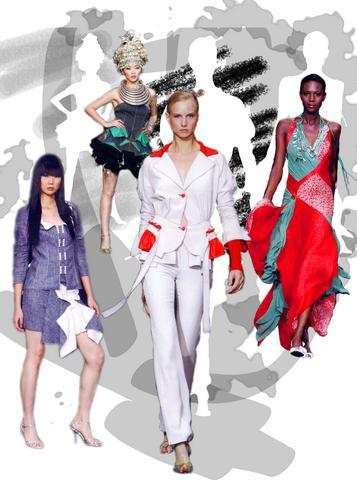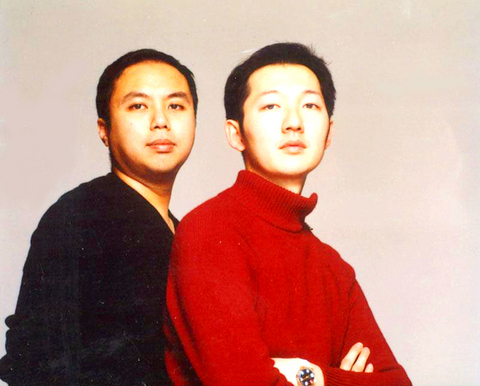The world of haute couture is shrinking. The number of top-end fashion houses is dwindling and conglomerates are gobbling up independent couturiers under larger corporate banners.
So, as svelte models stepped out onto the runway at Paris fashion week last month -- wearing designs inspired by local Aboriginal culture -- two Taiwanese men entered an exclusive club, one in which creativity, business acumen and serendipity are no guarantors of access.
Chien Yu-feng (簡鈺峰) and Shawn Pan (潘伯勳) are the first Taiwanese designers to show their collection at Paris fashion week, which attracts thousands of buyers and journalists and commands the attention of influential glossies such as Vogue.

The pair met at a New York fashion show, formed Yufengshawn fashion house in 1999 and produced their first collection for Fall/Winter 2000. Seven collections later they have 30 retail outlets throughout the world.
Their latest Shawnyi collection for Spring/Summer was a show of contradictions, one that reflected the dynamics of Chien and Pan's working relationship.
"My personality is sophisticated, glamorous and elegant," said Chien, the extroverted half of the partnership. Pan's timidity belies his avant-garde approach to fashion as he is responsible for the technological innovations used in the manufacture of the fabrics for their designs.

PHOTO COURTESY OF THE ARTISTS
Pan and Chien are the most successful Taiwanese fashion designers on the international stage to date. Such an accomplishment is due, in part, to the French education system and a government willing to foster young talent.
Chien, after having obtained a diploma from art college in 1994, worked for several local ready-to-wear designers including Shiatzy Chen, before moving to Paris to study at the L'Ecole de la Chambre Syndicate de la Couture Parisienne. Pan, after graduating from high school also moved to Paris to study at the Chambre Syndicate de la Couture.
On forming Yufengshawn the pair sought assistance from the French government, which helped them "find a place to work, paid for airline tickets to trade fairs that included one in Japan, covered the bill for the hotels and interpreters, and funded 50 percent of the cost of hiring models for the shows," said Chien. "The assistance lasts for five years, the time necessary to fully establish a viable brand."
The Federation Francaise de la Couture, headed by Didier Grumbach was established in 1868, and regulates the high-end fashion industry in France. It is overseen by the government and offers accredited designers like Pan and Chien help with copy-right protection and management issues.
It also organizes the October ready-to-wear Paris fashion week. Membership of the federation is highly sought after. Such assistance is not as forthcoming from Taiwan's government.
"But every country has different policies, for France and Italy fashion is important. The fashion industry is more important, they know how to do that better than [Taiwan]," Chien said.
However, as Taiwan's government is now promoting a shift to higher added-value design products, on which the Ministry of Economic Affairs says future economic development depends, more assistance is becoming available. The Council of Cultural Affairs has implemented a "Flagship Plan" to promote local fashion designers by encouraging exchanges and freeing up funding.
But, "it's too simple to just say that the government needs to help the fashion industry. Fashion designers must know the international fashion system. Right now Taiwanese fashion designers don't know that," said Chien. "Each country has local designers, and international designers, but Taiwan doesn't have international designers, just us. France also has a lot of local designers that can't make it into the international system."
Others view the government's position differently. For the industry as a whole, "if Taiwan wants to go international then the government must help," local designer Isabelle Wen (
Taiwan's fashion industry grew out of the Dihua Street fabric market when the nation enjoyed brisk economic growth in the 1970s. Two generations of fashion designers ensued, Wen said. The first generation included companies such as Golden Lion and Five Pennies, and they sought to construct fashion brands at a time when international fashion houses were securing a foothold in the local market.
Lifestyle marketing and sophisticated branding mark out the current generation. But despite having overseas retail outlets and recognizable branding the second generation remains localized.
"France has the international business environment and traditions to foster an international fashion industry," Chien said. "Taiwan's focus is on local industry."
For Chien, "the most important question is the design style. You cannot copy designs, you have to develop a style. It's very dangerous to be influenced too much by other people. Having a strong personality, different from everyone else is most important.
"Secondly, top designers have a developed perception of the kind of woman we want to dress; this has to be consistent throughout the different seasons. These two things are lacking in Taiwan designers. Number three is to take stories from history. For us we took inspiration from Taiwan's story."
Chien and Pan have started a diffusion line, and plan to open a flagship store in Taipei in April. The local-boys-made-good, the third generation of Taiwan fashion designers, are coming home.

May 18 to May 24 Pastor Yang Hsu’s (楊煦) congregation was shocked upon seeing the land he chose to build his orphanage. It was surrounded by mountains on three sides, and the only way to access it was to cross a river by foot. The soil was poor due to runoff, and large rocks strewn across the plot prevented much from growing. In addition, there was no running water or electricity. But it was all Yang could afford. He and his Indigenous Atayal wife Lin Feng-ying (林鳳英) had already been caring for 24 orphans in their home, and they were in

President William Lai (賴清德) yesterday delivered an address marking the first anniversary of his presidency. In the speech, Lai affirmed Taiwan’s global role in technology, trade and security. He announced economic and national security initiatives, and emphasized democratic values and cross-party cooperation. The following is the full text of his speech: Yesterday, outside of Beida Elementary School in New Taipei City’s Sanxia District (三峽), there was a major traffic accident that, sadly, claimed several lives and resulted in multiple injuries. The Executive Yuan immediately formed a task force, and last night I personally visited the victims in hospital. Central government agencies and the

Australia’s ABC last week published a piece on the recall campaign. The article emphasized the divisions in Taiwanese society and blamed the recall for worsening them. It quotes a supporter of the Taiwan People’s Party (TPP) as saying “I’m 43 years old, born and raised here, and I’ve never seen the country this divided in my entire life.” Apparently, as an adult, she slept through the post-election violence in 2000 and 2004 by the Chinese Nationalist Party (KMT), the veiled coup threats by the military when Chen Shui-bian (陳水扁) became president, the 2006 Red Shirt protests against him ginned up by

As with most of northern Thailand’s Chinese Nationalist Party (KMT) settlements, the village of Arunothai was only given a Thai name once the Thai government began in the 1970s to assert control over the border region and initiate a decades-long process of political integration. The village’s original name, bestowed by its Yunnanese founders when they first settled the valley in the late 1960s, was a Chinese name, Dagudi (大谷地), which literally translates as “a place for threshing rice.” At that time, these village founders did not know how permanent their settlement would be. Most of Arunothai’s first generation were soldiers